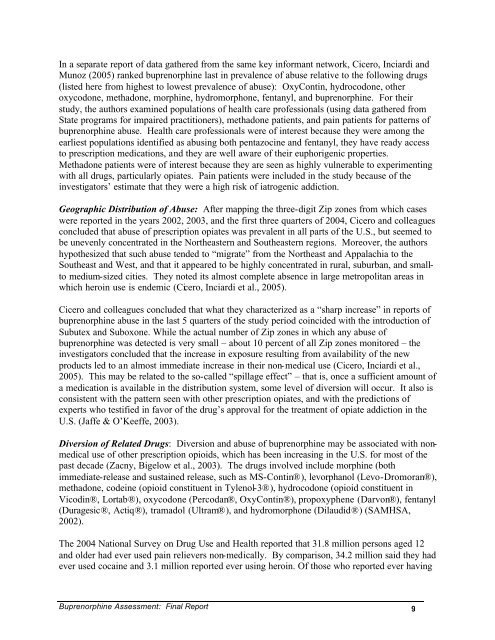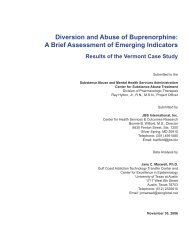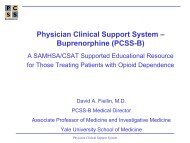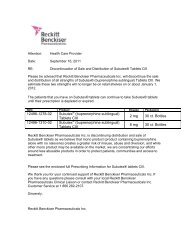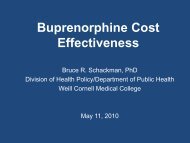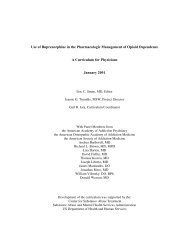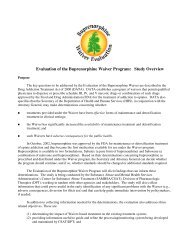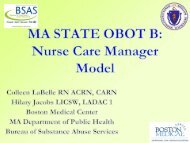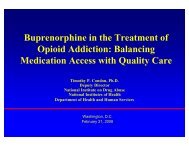Diversion and Abuse of Buprenorphine
Diversion and Abuse of Buprenorphine
Diversion and Abuse of Buprenorphine
Create successful ePaper yourself
Turn your PDF publications into a flip-book with our unique Google optimized e-Paper software.
In a separate report <strong>of</strong> data gathered from the same key informant network, Cicero, Inciardi <strong>and</strong><br />
Munoz (2005) ranked buprenorphine last in prevalence <strong>of</strong> abuse relative to the following drugs<br />
(listed here from highest to lowest prevalence <strong>of</strong> abuse): OxyContin, hydrocodone, other<br />
oxycodone, methadone, morphine, hydromorphone, fentanyl, <strong>and</strong> buprenorphine. For their<br />
study, the authors examined populations <strong>of</strong> health care pr<strong>of</strong>essionals (using data gathered from<br />
State programs for impaired practitioners), methadone patients, <strong>and</strong> pain patients for patterns <strong>of</strong><br />
buprenorphine abuse. Health care pr<strong>of</strong>essionals were <strong>of</strong> interest because they were among the<br />
earliest populations identified as abusing both pentazocine <strong>and</strong> fentanyl, they have ready access<br />
to prescription medications, <strong>and</strong> they are well aware <strong>of</strong> their euphorigenic properties.<br />
Methadone patients were <strong>of</strong> interest because they are seen as highly vulnerable to experimenting<br />
with all drugs, particularly opiates. Pain patients were included in the study because <strong>of</strong> the<br />
investigators’ estimate that they were a high risk <strong>of</strong> iatrogenic addiction.<br />
Geographic Distribution <strong>of</strong> <strong>Abuse</strong>: After mapping the three-digit Zip zones from which cases<br />
were reported in the years 2002, 2003, <strong>and</strong> the first three quarters <strong>of</strong> 2004, Cicero <strong>and</strong> colleagues<br />
concluded that abuse <strong>of</strong> prescription opiates was prevalent in all parts <strong>of</strong> the U.S., but seemed to<br />
be unevenly concentrated in the Northeastern <strong>and</strong> Southeastern regions. Moreover, the authors<br />
hypothesized that such abuse tended to “migrate” from the Northeast <strong>and</strong> Appalachia to the<br />
Southeast <strong>and</strong> West, <strong>and</strong> that it appeared to be highly concentrated in rural, suburban, <strong>and</strong> small-<br />
to medium-sized cities. They noted its almost complete absence in large metropolitan areas in<br />
which heroin use is endemic (Cicero, Inciardi et al., 2005).<br />
Cicero <strong>and</strong> colleagues concluded that what they characterized as a “sharp increase” in reports <strong>of</strong><br />
buprenorphine abuse in the last 5 quarters <strong>of</strong> the study period coincided with the introduction <strong>of</strong><br />
Subutex <strong>and</strong> Suboxone. While the actual number <strong>of</strong> Zip zones in which any abuse <strong>of</strong><br />
buprenorphine was detected is very small – about 10 percent <strong>of</strong> all Zip zones monitored – the<br />
investigators concluded that the increase in exposure resulting from availability <strong>of</strong> the new<br />
products led to an almost immediate increase in their non-medical use (Cicero, Inciardi et al.,<br />
2005). This may be related to the so-called “spillage effect” – that is, once a sufficient amount <strong>of</strong><br />
a medication is available in the distribution system, some level <strong>of</strong> diversion will occur. It also is<br />
consistent with the pattern seen with other prescription opiates, <strong>and</strong> with the predictions <strong>of</strong><br />
experts who testified in favor <strong>of</strong> the drug’s approval for the treatment <strong>of</strong> opiate addiction in the<br />
U.S. (Jaffe & O’Keeffe, 2003).<br />
<strong>Diversion</strong> <strong>of</strong> Related Drugs: <strong>Diversion</strong> <strong>and</strong> abuse <strong>of</strong> buprenorphine may be associated with nonmedical<br />
use <strong>of</strong> other prescription opioids, which has been increasing in the U.S. for most <strong>of</strong> the<br />
past decade (Zacny, Bigelow et al., 2003). The drugs involved include morphine (both<br />
immediate-release <strong>and</strong> sustained release, such as MS-Contin®), levorphanol (Levo-Dromoran®),<br />
methadone, codeine (opioid constituent in Tylenol-3®), hydrocodone (opioid constituent in<br />
Vicodin®, Lortab®), oxycodone (Percodan®, OxyContin®), propoxyphene (Darvon®), fentanyl<br />
(Duragesic®, Actiq®), tramadol (Ultram®), <strong>and</strong> hydromorphone (Dilaudid®) (SAMHSA,<br />
2002).<br />
The 2004 National Survey on Drug Use <strong>and</strong> Health reported that 31.8 million persons aged 12<br />
<strong>and</strong> older had ever used pain relievers non-medically. By comparison, 34.2 million said they had<br />
ever used cocaine <strong>and</strong> 3.1 million reported ever using heroin. Of those who reported ever having<br />
<strong>Buprenorphine</strong> Assessment: Final Report 9


